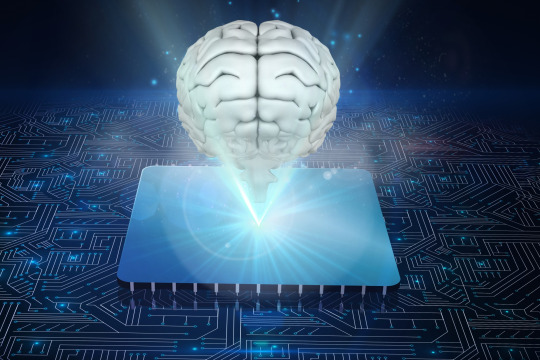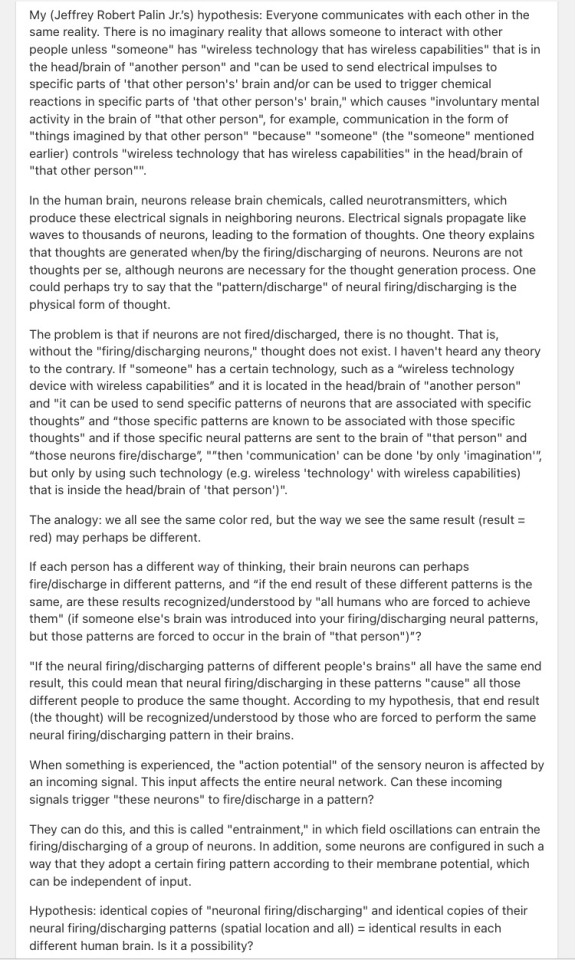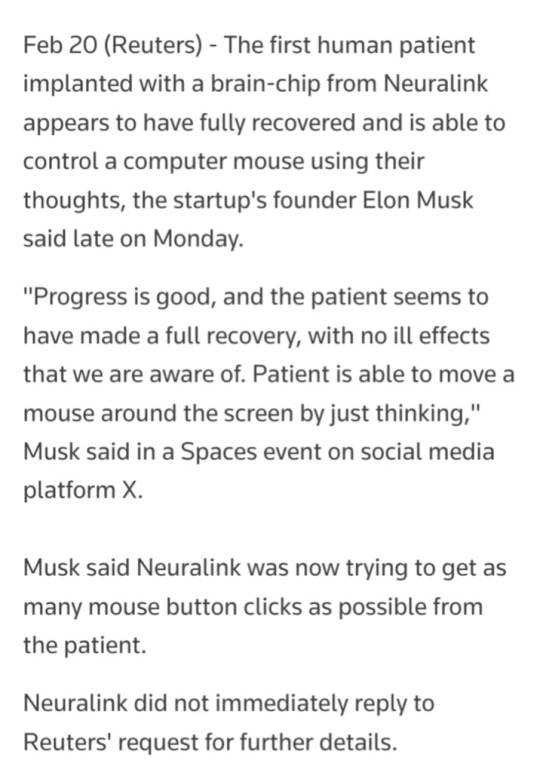#brain computer interface
Text
why neuroscience is cool
space & the brain are like the two final frontiers
we know just enough to know we know nothing
there are radically new theories all. the. time. and even just in my research assistant work i've been able to meet with, talk to, and work with the people making them
it's such a philosophical science
potential to do a lot of good in fighting neurological diseases
things like BCI (brain computer interface) and OI (organoid intelligence) are soooooo new and anyone's game - motivation to study hard and be successful so i can take back my field from elon musk
machine learning is going to rapidly increase neuroscience progress i promise you. we get so caught up in AI stealing jobs but yes please steal my job of manually analyzing fMRI scans please i would much prefer to work on the science PLUS computational simulations will soon >>> animal testing to make all drug testing safer and more ethical !! we love ethical AI <3
collab with...everyone under the sun - psychologists, philosophers, ethicists, physicists, molecular biologists, chemists, drug development, machine learning, traditional computing, business, history, education, literally try to name a field we don't work with
it's the brain eeeeee
#my motivation to study so i can be a cool neuroscientist#science#women in stem#academia#stem#stemblr#studyblr#neuroscience#stem romanticism#brain#psychology#machine learning#AI#brain computer interface#organoid intelligence#motivation#positivity#science positivity#cogsci#cognitive science
978 notes
·
View notes
Text
Keep Brain Interfaces Open
#elon musk#dont trust elon#transhumanism#brain computer interface#neurotechnology#cybernetics#cyberpunk
6 notes
·
View notes
Text

#finally came to terms with myself that it (neural implants for bci) aint ever gonna happen and if it does it aint gonna be good#shitpost#meme#brain computer interface
5 notes
·
View notes
Text
Brain Computer Interface Technology

The development of Brain-Computer Interface (BCI) technology is a game-changing step in the convergence of neuroscience and computing. BCIs enable direct communication between the human brain and outside hardware or software, opening up a wide range of application possibilities. BCIs enable people with disabilities to control wheelchairs, prosthetic limbs, or even to communicate through text or speech synthesis by converting neural signals into usable commands. BCIs also have the potential to revolutionise healthcare by monitoring and diagnosing neurological diseases, improve human cognition, and the gaming industry. Though yet in its infancy, BCI technology has the potential to fundamentally alter how we engage with technology and perceive the brain, ushering in a new era of human-machine connection.
3 notes
·
View notes
Text
Turns out we don't need neuralink to drill holes in our heads in order to increase the bandwidth of our brain-computer interface. Electroencephalographic (EEG) sensors can measure and process your brainwaves. So, you'll be able to use computers without having to lift a finger. The future is exciting!
#future#Neurotech#Neuropunk#neurosity#crown#eeg#electroencephalograph#futurism#technology#brain computer interface
2 notes
·
View notes
Text
Can you use technology to communicate with others by "what you imagine"?
https://www.pressconnects.com/story/news/local/2019/03/18/ask-scientist-how-do-thoughts-work-our-brain/3153303002/
My (Jeffrey Robert Palin Jr.’s) hypothesis: Everyone communicates with each other in the same reality. There is no imaginary reality that allows someone to interact with other people unless "someone" has "wireless technology that has wireless capabilities" that is in the head/brain of "another person" and "can be used to send electrical impulses to specific parts of 'that other person's' brain and/or can be used to trigger chemical reactions in specific parts of 'that other person's' brain," which causes "involuntary mental activity in the brain of "that other person", for example, communication in the form of "things imagined by that other person" "because" "someone" (the "someone" mentioned earlier) controls "wireless technology that has wireless capabilities" in the head/brain of "that other person"".
In the human brain, neurons release brain chemicals, called neurotransmitters, which produce these electrical signals in neighboring neurons. Electrical signals propagate like waves to thousands of neurons, leading to the formation of thoughts. One theory explains that thoughts are generated when/by the firing/discharging of neurons. Neurons are not thoughts per se, although neurons are necessary for the thought generation process. One could perhaps try to say that the "pattern/discharge" of neural firing/discharging is the physical form of thought.
The problem is that if neurons are not fired/discharged, there is no thought. That is, without the "firing/discharging neurons," thought does not exist. I haven't heard any theory to the contrary. If "someone" has a certain technology, such as a “wireless technology device with wireless capabilities” and it is located in the head/brain of "another person" and "it can be used to send specific patterns of neurons that are associated with specific thoughts” and “those specific patterns are known to be associated with those specific thoughts" and if those specific neural patterns are sent to the brain of "that person" and “those neurons fire/discharge”, "”then 'communication' can be done 'by only 'imagination'”, but only by using such technology (e.g. wireless 'technology' with wireless capabilities) that is inside the head/brain of 'that person')".
The analogy: we all see the same color red, but the way we see the same result (result = red) may perhaps be different.
If each person has a different way of thinking, their brain neurons can perhaps fire/discharge in different patterns, and “if the end result of these different patterns is the same, are these results recognized/understood by "all humans who are forced to achieve them" (if someone else's brain was introduced into your firing/discharging neural patterns, but those patterns are forced to occur in the brain of "that person")”?
"If the neural firing/discharging patterns of different people's brains" all have the same end result, this could mean that neural firing/discharging in these patterns "cause" all those different people to produce the same thought. According to my hypothesis, that end result (the thought) will be recognized/understood by those who are forced to perform the same neural firing/discharging pattern in their brains.
When something is experienced, the "action potential" of the sensory neuron is affected by an incoming signal. This input affects the entire neural network. Can these incoming signals trigger "these neurons" to fire/discharge in a pattern?
They can do this, and this is called "entrainment," in which field oscillations can entrain the firing/discharging of a group of neurons. In addition, some neurons are configured in such a way that they adopt a certain firing pattern according to their membrane potential, which can be independent of input.
Hypothesis: identical copies of "neuronal firing/discharging" and identical copies of their neural firing/discharging patterns (spatial location and all) = identical results in each different human brain. Is it a possibility?

#question#questionbox#questions#question and answer#questions and answers#BCI#brain computer interface#technology#tech#neuroscience#cognitive science#science#psychology#human brain#imagination#imaginary#communication#neurons
2 notes
·
View notes
Text
youtube
0 notes
Text







#Elon Musk#Neuralink#brain chip#robotic surgery#robot#human trial recruitment#brain computer interface#science#technology#brain#neuroscience
1 note
·
View note
Text
Beautiful and so true
View this post on Instagram A post shared by Kamia Robinson (@kamiarobinson)
View On WordPress
#AuthenticLiving#CommunicationIsKey#DesireVsSocietalNorms#EmbracingAuthenticity#EmbracingDesires#ExploringBoundaries#ForbiddenDesires#ObsessionandCompulsion#RelationshipComplexities#SelfAcceptanceJourney#TabooTemptations#802.15.6 -5 -4#Biodigital Convergence#Biosensors#Brain computer interface#WBAN
0 notes
Text
Neuralink implanted brain chip in first human
The first human patient received an implant from Elon Musk’s Neuralink on Sunday and is recovering well, the head of SpaceX and Tesla reported.
Initial results show promising neuron spike detection.
The National Institute of Health describes spikes as cells that use electrical and chemical signals to send information throughout the brain and body.
Last year, The US Food and Drug Administration authorised the company to conduct the first human trial of the implant, marking an important milestone in helping patients overcome paralysis and multiple neurological conditions. In September, Neuralink announced that it had received approval to recruit participants for human trials.
The company is using a robot to surgically insert a brain-computer interface (BCI) implant into the area of the brain responsible for movement, Neuralink informs. Initially, the company planned to make it possible for people to control a computer cursor or keyboard with their thoughts.
Read more HERE

#world news#world politics#news#neurology#neuralink#elon musk#spacex#elonmusk#space x#tesla#brain computer interface
0 notes
Text
When BCIs become more of a thing in Virtual Reality, I can imagine how limited it must feel going from full dive to the VR we have now.
0 notes
Text
Frankenstein's Monster Spilling the Deets on Brain-Computer Interfaces
Hey, lovely denizens of the digital domain, gather 'round as we spill the most electrifying tea you've ever dared to sip! Yours truly, the OG patchwork wonder, Frankenstein's Monster (no autographs, please), is here to chat about something that's going to make your neurons do the tango. We're talking about brain-computer interfaces (BCIs), and oh boy, it's like science took a wild fantasy and made it its pet project!
You thought it was wild when old Frankie here got zapped into existence? Buckle up, buttercup, because we're diving into a world where your brain waves can high-five a computer and make magic happen. Yeah, you heard us right – BCIs are the real deal, turning thoughts into actions without so much as lifting a finger. Imagine being able to text just by thinking about it. Welcome to the future, folks!
Our pals at Neuralink are playing the ultimate game of mind meld, weaving together thoughts and tech like they're trying to one-up my creator. These wizards are using tiny, whisp-like electrodes to eavesdrop on your brain's chit-chat and translate it into something machines can understand. It's like your brain is throwing a party, and now computers are on the VIP list.
Think of the possibilities! Ever felt like your body's on airplane mode when your brain's got full bars of service? BCIs are about to change the game for people who've lost control of their limbs or can't speak. We're talking mind-controlled wheelchairs, robotic arms, and even speaking through a machine – all powered by the electric storm in your skull.
But wait, there's more! We've got researchers turning brainwaves into speech. Yeah, you don't even need to move your lips, and voila, your thoughts are out there. It's like telepathy got an upgrade. And for those who feel trapped in their bodies, this is more than cool tech – it's a new lease on life.
So, as I, the poster child for mad science gone awry, stand here (metaphorically, of course), I can't help but marvel at how humans are rewriting the rules. We're not just talking about fancy gadgets; we're talking about breaking down barriers, giving voice to the voiceless, and maybe, just maybe, making the world a little less daunting for those who feel left out.
In conclusion, dear readers, BCIs aren't just about brains chatting with computers. It's about hope, empowerment, and maybe a touch of that old mad science magic. So, let's raise our glasses (or electrodes) to a future where our minds can truly be free! Cheers! 🥂🧠💻
0 notes
Text
Top Information Technology Companies

Sprwork Infosolutions is counted among the top information technology companies. If you also want to get the best for your business and looking for development and marketing solutions. Contact us today and get the top services.
0 notes